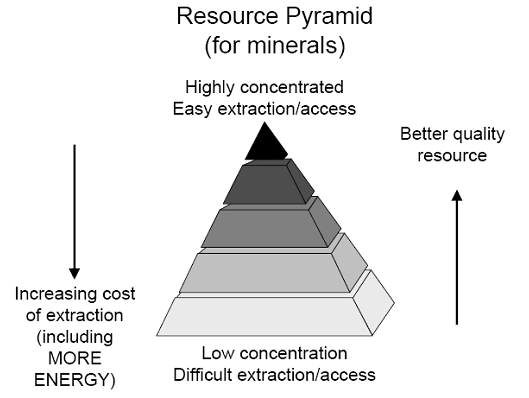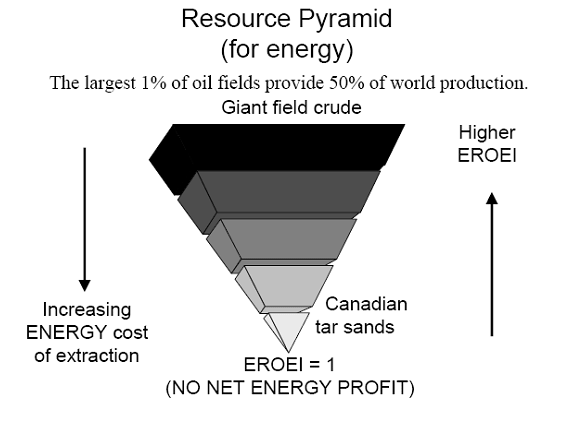Cornucopians - those who believe the Earth’s resources are boundless - have a clever mental trick to avoid acknowledging that the planet is finite. It is commonly called the “resource pyramid”.
The argument goes like this. When we first begin to extract a substance from a resource we exploit that resource in which the substance is most concentrated (and so easiest to purify) and/or most accessible.
An example of this would be digging large gold nuggets out of riverbanks in the Victorian goldfields in the 1850s or mining phosphate-rich guano on the Pacific island of Nauru by simply scooping it up and bagging it. However, as you probably know, the alluvial gold of Victoria and the guano on Nauru were both mined out many years ago.
Advertisement
You might think that this would lead to a severe shortage of these materials but this is where the resource pyramid works it magic. As these resources begin to become scarce their price rises. The higher price now makes it economically viable to extract the substance from a less accessible and/or less concentrated source. Amazingly, the total amount of the substance present in this lower-grade resource is greater than in the original, most concentrated resource. This pattern repeats. As the less concentrated resource begins to be mined out the price of the substance rises ever higher so that extracting it from an even lower grade/less accessible source becomes economically viable.
The total amount of the substance present in the lowest grade of resource is greater than previously. By this argument we can never run out of a substance because the more we use, the more becomes economically viable to extract. Our planet truly is a magic pudding! This idea can be represented as a pyramid with the small amount of most concentrated/accessible substance at the top and successively larger amounts of the substance in lower grades of ore, and so on, as we move down:

The resource pyramid idea contains a hidden assumption - that energy is cheap and abundant. In fact, it is the price of energy that ultimately determines the base of the resource pyramid. At each step down the resource pyramid the substance sought is less pure and/or accessible and so it requires more energy to extract.
At some point the cost of the energy required to exploit the resource will equal the value of the substance obtained. It is at that moment that exploitation of the resource ends. To date, energy has been so cheap that we have rarely (if at all) been faced with having to end exploitation. (No examples spring to my mind. Maybe readers can suggest some in comments on this article.) The high price of any substance has usually resulted in substitution by something else more abundant.
When it comes to discussions of oil or other energy sources Cornucopians apply the resource pyramid argument in one form or another. The following comment by the CEO of Exxon Mobil Australia is a good example:
Advertisement
According to the US Geological Survey (USGS), the Earth currently has more than 3 trillion barrels of conventional recoverable resource and so far we’ve produced 1 trillion of that. Conservative estimates of heavy oil and shale oil push the total recoverable resource to over four trillion barrels.
And more recently, the chief economist of BP said:
Therefore there will never be a moment when the world runs out of oil because there will always be a price at which the last drop of oil can clear the market. And you can turn anything into oil if you are willing to pay the financial and environmental price.
This contrasts with those convinced that a peak of oil production is imminent who mostly believe that only about 1 trillion barrels of extractable conventional oil remain. (Note - it is worthwhile remembering that the peak oil concept is about the rate of oil extraction, not the total extractable reserves remaining.)
What the Cornucopians do not seem to understand is that energy must be invested to produce energy. If hydrocarbons are being mined for energy then exploration must occur, wells must be drilled, the oil or gas must be extracted and separated into various fuel grades before further distribution to vehicular fuel tanks. (The process is much more complicated than this but you get the general idea.) It is an energy intensive process.
Earlier in the Oil Age when the most easily accessible oil fields were first tapped a relatively small energy investment gave a huge energy profit - by some estimates a profit ratio of 100-fold or greater.
As oil extraction from a field proceeds the pressure drops requiring more and more energy-intensive methods to be used to continue the extraction - such as pumping down gas or water to maintain pressure and/or pumping up the oil. Also, as the Oil Age has proceeded the size/accessibility of oil fields discovered has decreased (since larger and more accessible fields are easier to find and so are found first) and the more intensive exploration and drilling required to exploit the smaller/less accessible oil fields requires more energy.
If we begin to exploit non-conventional sources of oil then the energy inputs required are greater still, meaning that the net energy produced from each energy unit invested decreases. What this means is that as we use up our highest quality/most accessible hydrocarbon resources and begin to consume lower quality/less accessible resources, the net energy produced from each unit invested decreases.
If the object of the mining activity is net energy production (i.e. the actual energy left over after the inputs to mining, processing and distributing it have been subtracted) then the volume of net energy decreases as the resource quality declines, i.e. as we move down the resource “pyramid”.
In fact, the resource pyramid for net energy resembles more a pyramid standing on its apex! This is shown in the figure below where EROEI is the acronym for Energy Returned on Energy Invested. Once net energy production from the extraction process falls to zero (i.e. EROEI = 1) then it is impossible for the activity to continue (unless the activity is subsidised with energy from another source).

It is true that the world possesses hydrocarbon resources equivalent to many trillions of barrels of oil but these will never be harvested for energy production. It may be that they will be mined, for example, for plastics production at some future date but the energy to do the mining will come from elsewhere.
Many readers may believe that technology will solve this net energy problem by providing less energy intensive methods to extract hydrocarbons from difficult resources. While technology can have a marginal impact, there are some minimum levels of energy investment that cannot be circumvented. For example, the molecular forces holding oil within its constraining rock matrix will always require a certain minimum application of energy to overcome and nothing can magically levitate oil at low pressure up from a deposit several kilometres below ground.
Even if all the low quality hydrocarbon resources could be exploited, the rate at which these difficult deposits could be mined would be low and so would be the rate at which we could obtain energy from them.
The ultimate consequence is that, at some point (“peak net energy”) the rate at which we will obtain energy from fossil sources must decline. An interesting example of this is energy production from coal in the USA. While the tonnage of coal mined in the USA is now at record levels, coal quality is declining and the total energy content of the coal has been decreasing since 1998 (PDF 534KB)!
Also, the total rate of oil production is currently on a plateau and may have peaked but we know that the best grades of oil requiring least processing for gasoline/petrol production (“light sweet crude”) peaked by 2004 and that new oil production is increasingly “heavy and sour”. This, combined with the additional energy required to exploit smaller and more remote oil fields means that we must be at, or close to, the peak rate of net energy production from oil.
The resource pyramid is an interesting concept that allows economists to argue that resources are unlimited. However, like so much economic theory, it is only an illusion supported by cheap and abundant energy.
Note: Factors influencing the resource pyramid concept are discussed in detail in a 2002 article in Geotimes. The authors place great significance on advancement of technology for increasing resource availability but they never mention net energy.